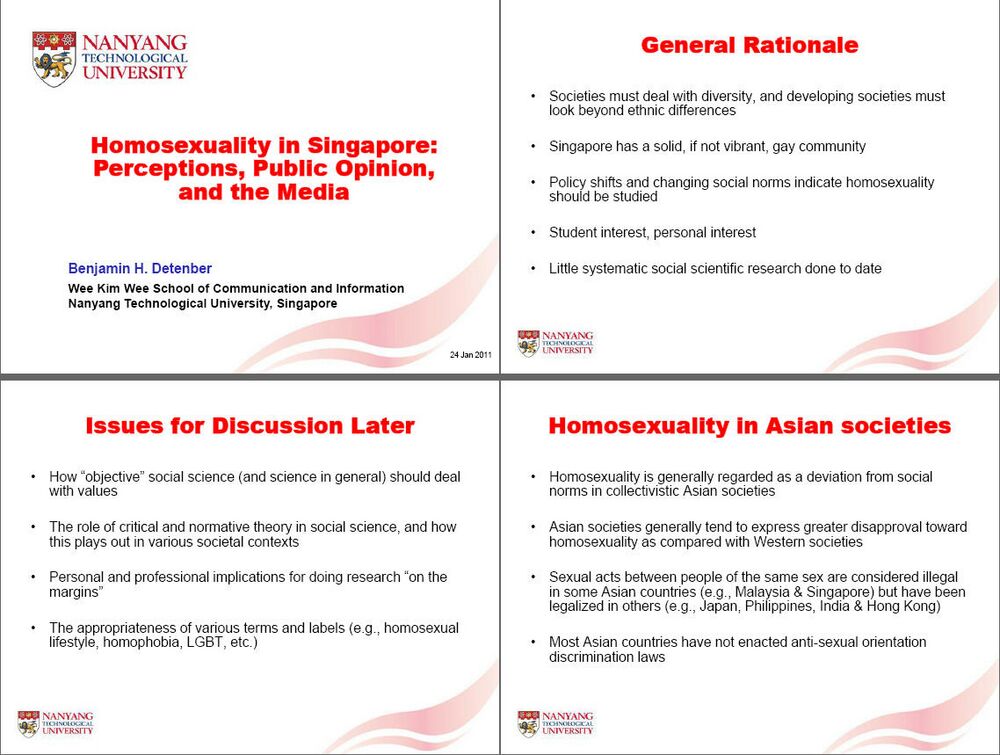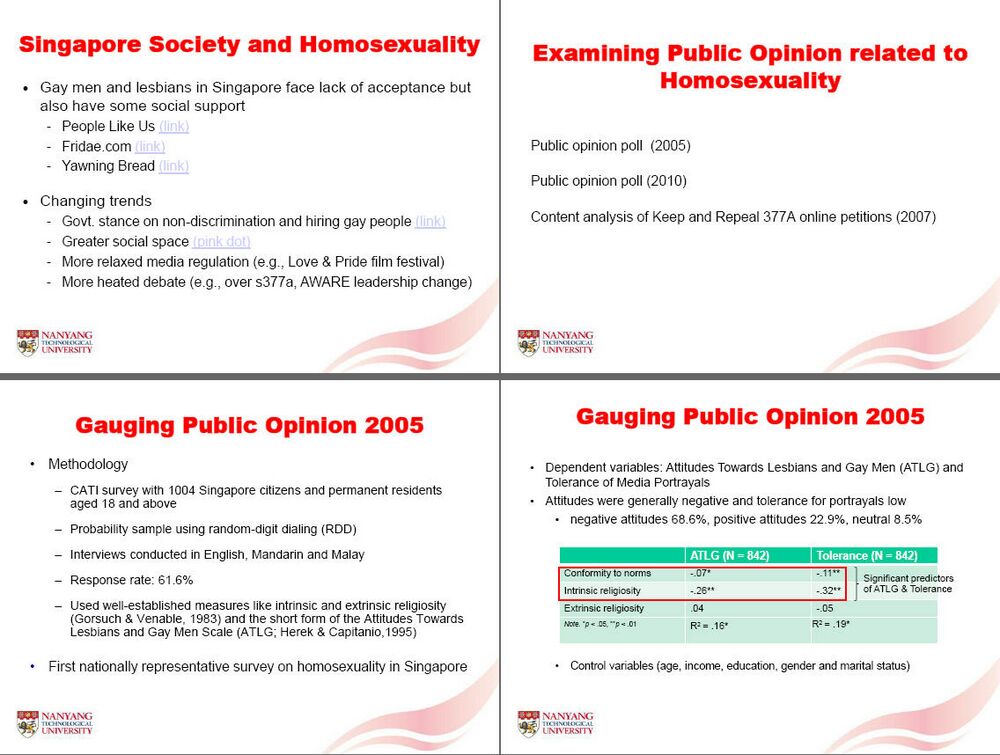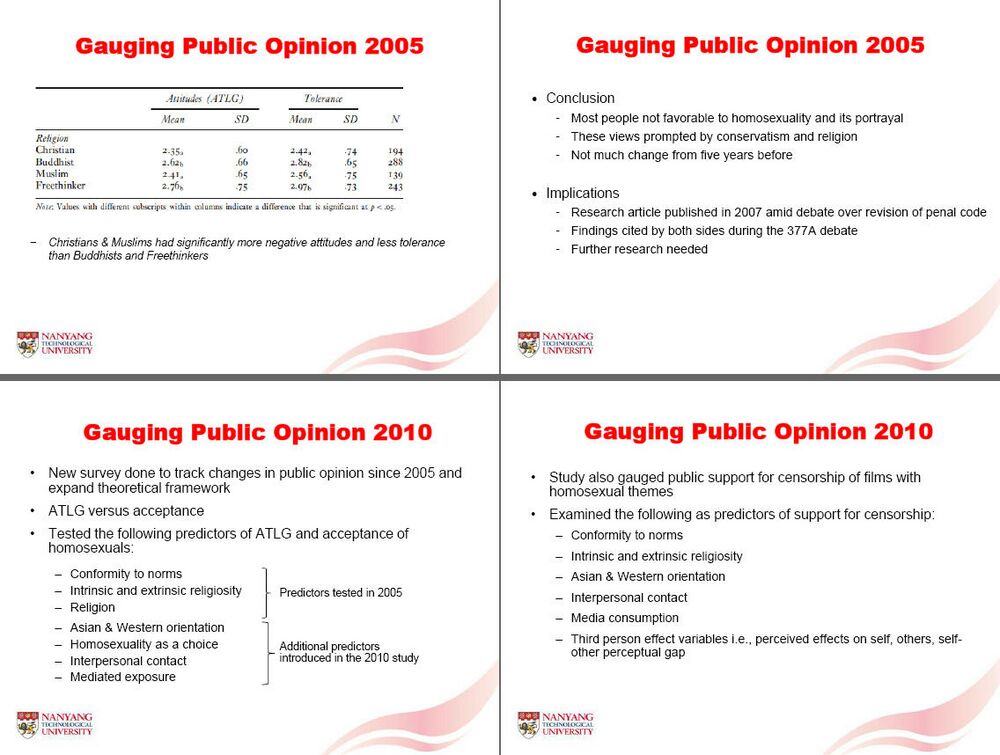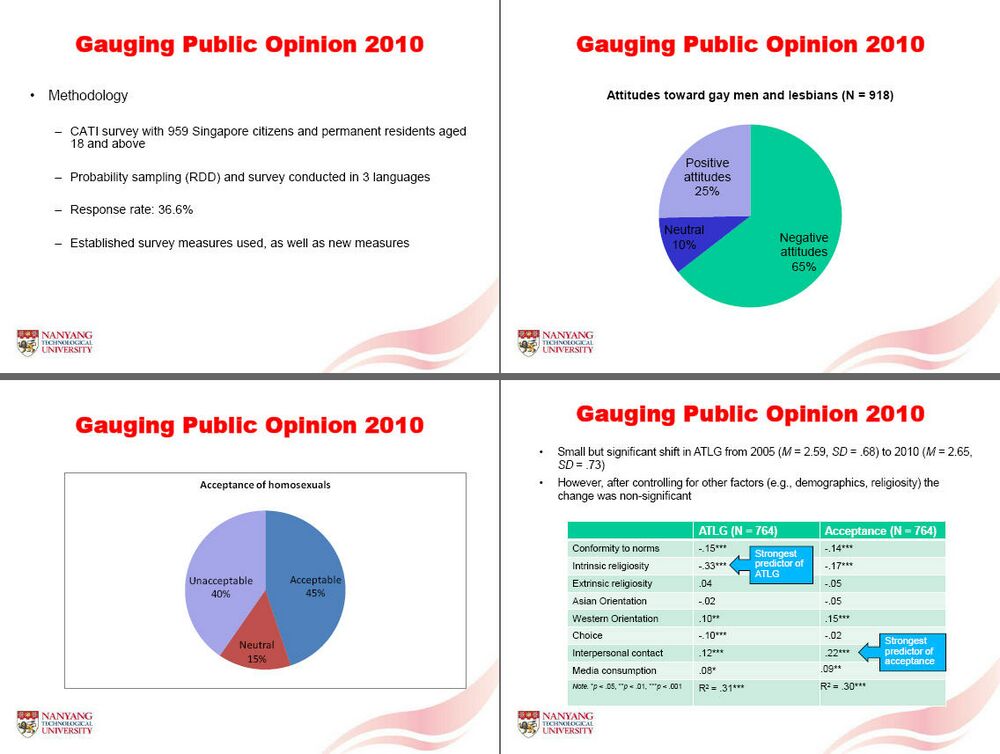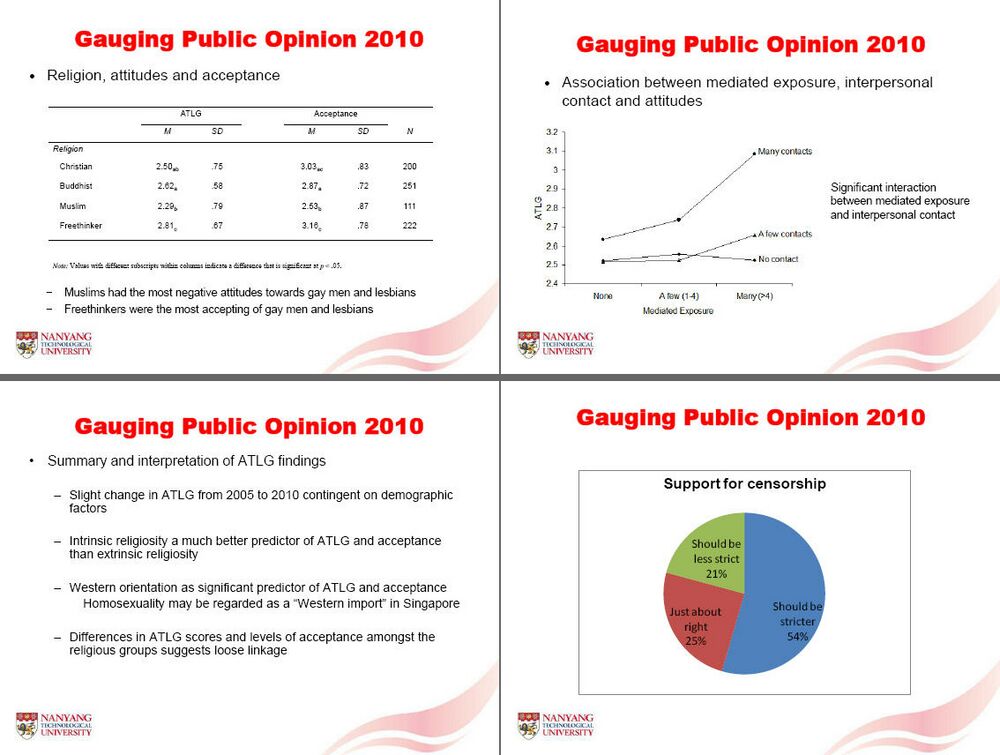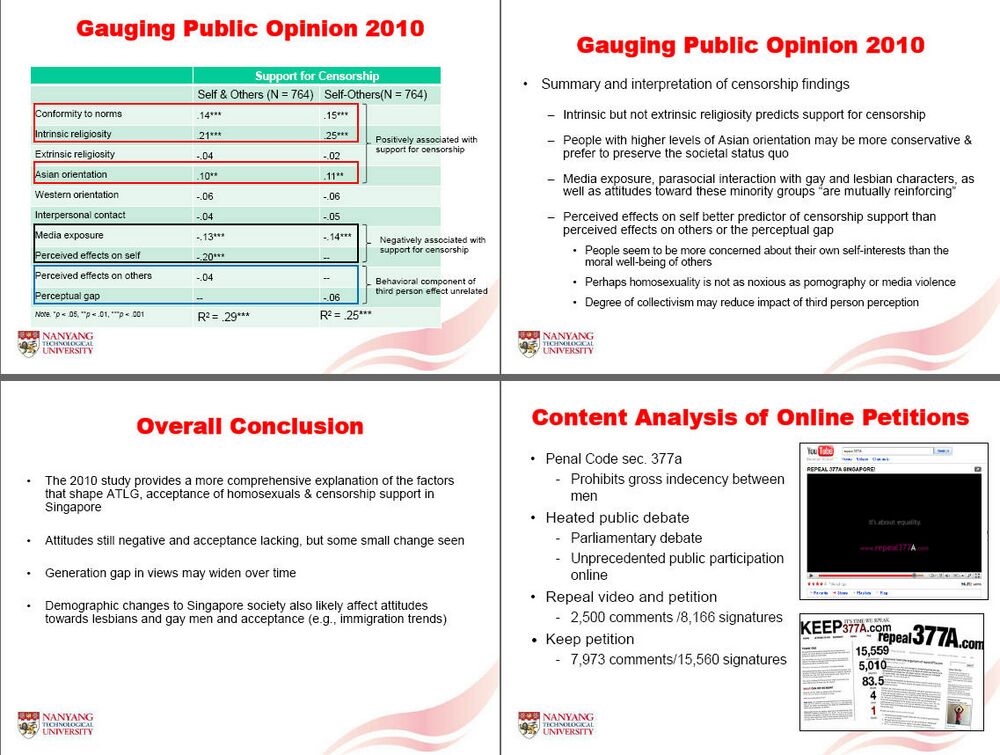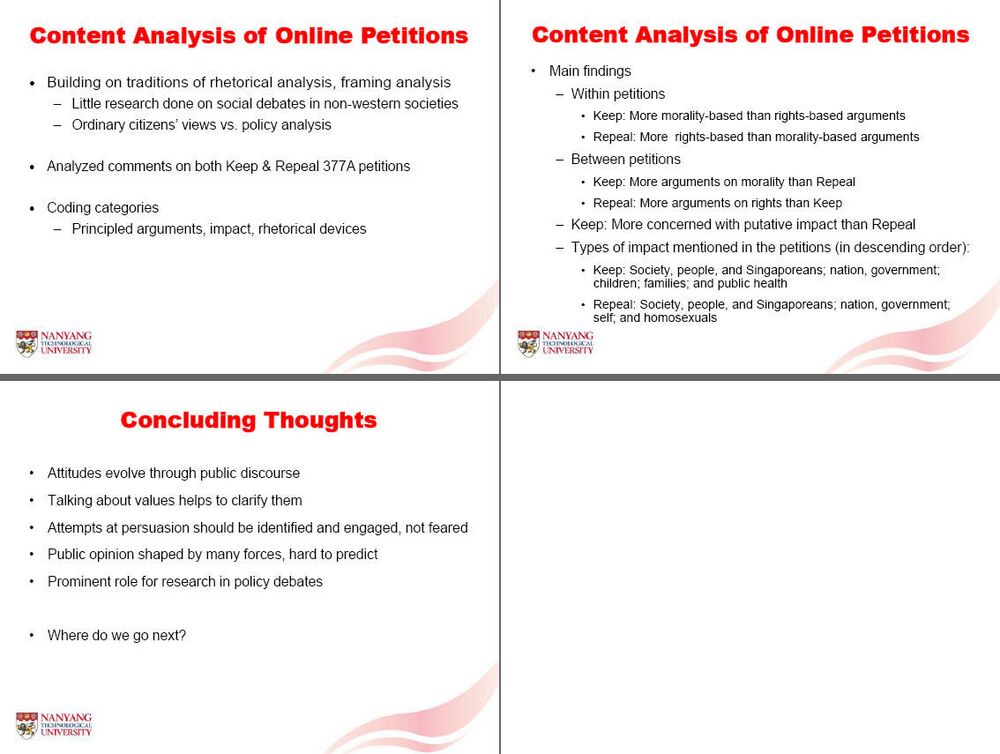Introduction[edit | edit source]
This is an archive of the PDF presentation of the study, "Homosexuality in Singapore: Perceptions, Public Opinion, and the Media" by Assoc. Prof. Benjamin H. Detenber of the Wee Kim Wee School of Communication and Information, Nanyang Technological University, Singapore dated 24 Jan 2011.
The original document can be downloaded here:[1]
Screen grabs of the PDF[edit | edit source]
Editable text of the PDF[edit | edit source]
General Rationale[edit | edit source]
•Societies must deal with diversity, and developing societies must look beyond ethnic differences •Singapore has a solid, if not vibrant, gay community •Policy shifts and changing social norms indicate homosexuality should be studied •Student interest, personal interest •Little systematic social scientific research done to date Issues for Discussion Later •How “objective” social science (and science in general) should deal with values •The role of critical and normative theory in social science, and how this plays out in various societal contexts •Personal and professional implications for doing research “on the margins” •The appropriateness of various terms and labels (e.g., homosexual lifestyle, homophobia, LGBT, etc.)
Homosexuality in Asian societies[edit | edit source]
•Homosexuality is generally regarded as a deviation from social norms in collectivistic Asian societies •Asian societies generally tend to express greater disapproval toward homosexuality as compared with Western societies •Sexual acts between people of the same sex are considered illegal in some Asian countries (e.g., Malaysia & Singapore) but have been legalized in others (e.g., Japan, Philippines, India & Hong Kong) •Most Asian countries have not enacted anti-sexual orientation discrimination laws Singapore Society and Homosexuality •Gay men and lesbians in Singapore face lack of acceptance but also have some social support –People Like Us (link) –Fridae.com (link) –Yawning Bread (link) •Changing trends –Govt. stance on non-discrimination and hiring gay people (link) –Greater social space (pink dot) –More relaxed media regulation (e.g., Love & Pride film festival) –More heated debate (e.g., over s377a, AWARE leadership change)
[edit | edit source]
- Public opinion poll (2005)
- Public opinion poll (2010)
- Content analysis of Keep and Repeal 377A online petitions (2007)
Gauging Public Opinion 2005[edit | edit source]
•Methodology –CATI survey with 1004 Singapore citizens and permanent residents aged 18 and above –Probability sample using random-digit dialing (RDD) –Interviews conducted in English, Mandarin and Malay –Response rate: 61.6% –Used well-established measures like intrinsic and extrinsic religiosity (Gorsuch& Venable, 1983) and the short form of the Attitudes Towards Lesbians and Gay Men Scale (ATLG; Herek& Capitanio,1995) •First nationally representative survey on homosexuality in Singapore Gauging Public Opinion 2005 •Dependent variables: Attitudes Towards Lesbians and Gay Men (ATLG) and Tolerance of Media Portrayals •Attitudes were generally negative and tolerance for portrayals low •negative attitudes 68.6%, positive attitudes 22.9%, neutral 8.5% •Control variables (age, income, education, gender and marital status) ATLG (N = 842) Tolerance (N = 842) Conformity to norms -.07* -.11** Intrinsic religiosity -.26** -.32** Extrinsic religiosity .04 -.05 Note.*p < .05, **p < .01 R2 = .16* R2 = .19* Significant predictors of ATLG & Tolerance Gauging Public Opinion 2005 -Christians & Muslims had significantly more negative attitudes and less tolerance than Buddhists and Freethinkers Gauging Public Opinion 2005 •Conclusion –Most people not favorable to homosexuality and its portrayal –These views prompted by conservatism and religion –Not much change from five years before •Implications –Research article published in 2007 amid debate over revision of penal code –Findings cited by both sides during the 377A debate –Further research needed •New survey done to track changes in public opinion since 2005 and expand theoretical framework •ATLG versus acceptance •Tested the following predictors of ATLG and acceptance of homosexuals: –Conformity to norms –Intrinsic and extrinsic religiosity –Religion –Asian & Western orientation –Homosexuality as a choice –Interpersonal contact –Mediated exposure
Gauging Public Opinion 2010[edit | edit source]
Predictors tested in 2005 Additional predictors introduced in the 2010 study •Study also gauged public support for censorship of films with homosexual themes •Examined the following as predictors of support for censorship: –Conformity to norms –Intrinsic and extrinsic religiosity –Asian & Western orientation –Interpersonal contact –Media consumption –Third person effect variables i.e., perceived effects on self, others, self-other perceptual gap •Methodology –CATI survey with 959 Singapore citizens and permanent residents aged 18 and above –Probability sampling (RDD) and survey conducted in 3 languages –Response rate: 36.6% –Established survey measures used, as well as new measures Negative attitudes65%Neutral10%Positive attitudes25%Attitudes toward gay men and lesbians (N = 918)
Acceptable45%Neutral15%Unacceptable40%Acceptance of homosexuals
•Small but significant shift in ATLG from 2005 (M= 2.59, SD= .68) to 2010 (M= 2.65, SD= .73) •However, after controlling for other factors (e.g., demographics, religiosity) the change was non-significant ATLG (N = 764) Acceptance (N = 764) Conformity to norms -.15*** -.14*** Intrinsic religiosity -.33*** -.17*** Extrinsic religiosity .04 -.05 Asian Orientation -.02 -.05 Western Orientation .10** .15*** Choice -.10*** -.02 Interpersonal contact .12*** .22*** Media consumption .08* .09** Note.*p < .05, **p < .01, ***p< .001 R2 = .31*** R2 = .30***Strongest predictor of ATLG Strongest predictor of acceptance ATLG Acceptance M SD M SD N Religion Christian 2.50ab .75 3.03ac .83 200 Buddhist 2.62a .58 2.87a .72 251 Muslim 2.29b .79 2.53b .87 111 Freethinker 2.81c .67 3.16c .78 222 Note: Values with different subscripts within columns indicate a difference that is significant at p< .05. -Muslims had the most negative attitudes towards gay men and lesbians -Freethinkers were the most accepting of gay men and lesbians •Religion, attitudes and acceptance Significant interaction between mediated exposure and interpersonal contact •Association between mediated exposure, interpersonal contact and attitudes
•Summary and interpretation of ATLG findings –Slight change in ATLG from 2005 to 2010 contingent on demographic factors –Intrinsic religiosity a much better predictor of ATLG and acceptance than extrinsic religiosity –Western orientation as significant predictor of ATLG and acceptance Homosexuality may be regarded as a “Western import” in Singapore –Differences in ATLG scores and levels of acceptance amongst the religious groups suggests loose linkage
Should be stricter54%Just about right25%Should be less strict21%Support for censorship
Support for Censorship Self & Others (N = 764) Self-Others(N = 764) Conformity to norms .14*** .15*** Intrinsic religiosity .21*** .25*** Extrinsic religiosity -.04 -.02 Asian orientation .10** .11** Western orientation -.06 -.06 Interpersonal contact -.04 -.05 Media exposure -.13*** -.14*** Perceived effects on self -.20*** -- Perceived effects on others -.04 -- Perceptual gap -- -.06 Note.*p < .05, **p < .01, ***p< .001 R2 = .29*** R2 = .25*** Positively associated with support for censorship Negatively associated with support for censorship Behavioral component of third person effect unrelated
•Summary and interpretation of censorship findings –Intrinsic but not extrinsic religiosity predicts support for censorship –People with higher levels of Asian orientation may be more conservative & prefer to preserve the societal status quo –Media exposure, parasocial interaction with gay and lesbian characters, as well as attitudes toward these minority groups “are mutually reinforcing” –Perceived effects on self better predictor of censorship support than perceived effects on others or the perceptual gap •People seem to be more concerned about their own self-interests than the moral well-being of others •Perhaps homosexuality is not as noxious as pornography or media violence •Degree of collectivism may reduce impact of third person perception
Overall Conclusion[edit | edit source]
•The 2010 study provides a more comprehensive explanation of the factors that shape ATLG, acceptance of homosexuals & censorship support in Singapore •Attitudes still negative and acceptance lacking, but some small change seen •Generation gap in views may widen over time •Demographic changes to Singapore society also likely affect attitudes towards lesbians and gay men and acceptance (e.g., immigration trends) Content Analysis of Online Petitions •Penal Code sec. 377a –Prohibits gross indecency between men •Heated public debate –Parliamentary debate –Unprecedented public participation online •Repeal video and petition –2,500 comments /8,166 signatures •Keep petition –7,973 comments/15,560 signatures Content Analysis of Online Petitions •Building on traditions of rhetorical analysis, framing analysis –Little research done on social debates in non-western societies –Ordinary citizens’ views vs. policy analysis •Analyzed comments on both Keep & Repeal 377A petitions •Coding categories –Principled arguments, impact, rhetorical devices
Content Analysis of Online Petitions[edit | edit source]
•Main findings –Within petitions •Keep: More morality-based than rights-based arguments •Repeal: More rights-based than morality-based arguments –Between petitions •Keep: More arguments on morality than Repeal •Repeal: More arguments on rights than Keep –Keep: More concerned with putative impact than Repeal –Types of impact mentioned in the petitions (in descending order): •Keep: Society, people, and Singaporeans; nation, government; children; families; and public health •Repeal: Society, people, and Singaporeans; nation, government; self; and homosexuals
Concluding Thoughts[edit | edit source]
•Attitudes evolve through public discourse •Talking about values helps to clarify them •Attempts at persuasion should be identified and engaged, not feared •Public opinion shaped by many forces, hard to predict •Prominent role for research in policy debates •Where do we go next?
See also[edit | edit source]
- Homosexuality in Singapore
- Section 377A of the Singapore Penal Code
- Discrimination against homosexuals in Singapore
External links[edit | edit source]
- Ng Yi-Sheng, "Gay marriage in Singapore: it’s only a matter of time", Trevvy, 13 July 2012:[2].
